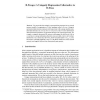Free Online Productivity Tools
i2Speak
i2Symbol
i2OCR
iTex2Img
iWeb2Print
iWeb2Shot
i2Type
iPdf2Split
iPdf2Merge
i2Bopomofo
i2Arabic
i2Style
i2Image
i2PDF
iLatex2Rtf
Sci2ools
ICALP
2009
Springer
2009
Springer
B-Treaps: A Uniquely Represented Alternative to B-Trees
We present the first uniquely represented data structure for an external memory model of computation, a B-tree analogue called a B-treap. Uniquely represented data structures represent each logical state with a unique machine state. Such data structures are strongly history-independent; they reveal no information about the historical sequence of operations that led to the current logical state. For example, a uniquely represented file-system would support the deletion of a file in a way that, in a strong information-theoretic sense, provably removes all evidence that the file ever existed. Like the B-tree, the B-treap has depth O(logB n), uses linear space with high probability, where B is the block transfer size of the external memory, and supports efficient one-dimensional range queries.
B-tree Analogue | Current Logical State | ICALP 2009 | Such Data Structures | Theoretical Computer Science |
| Added | 03 Dec 2009 |
| Updated | 03 Dec 2009 |
| Type | Conference |
| Year | 2009 |
| Where | ICALP |
| Authors | Daniel Golovin |
Comments (0)

